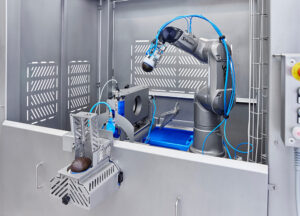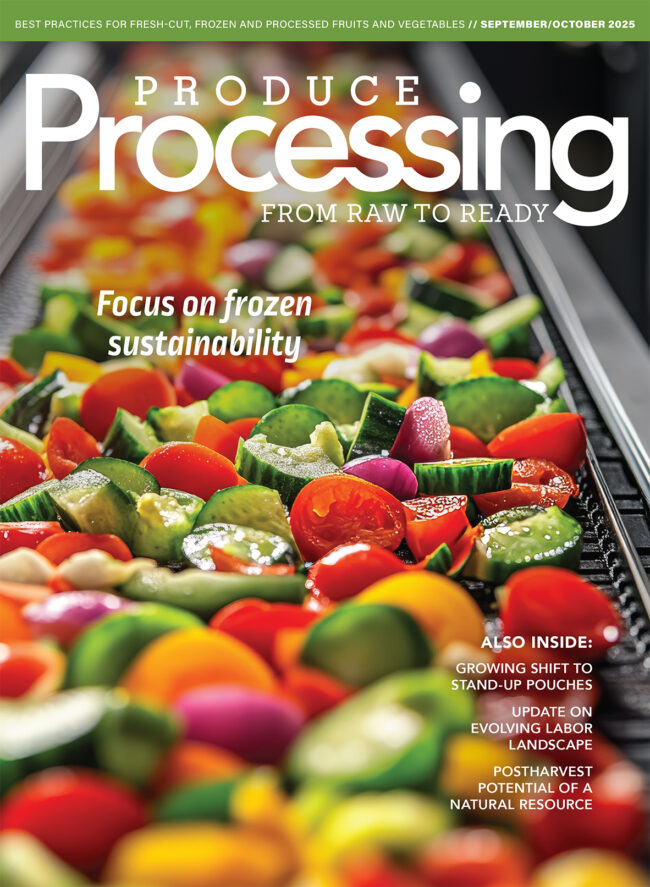Avocado automation: Robotic solution smoothes processing for sensitive fruit
Kronen’s automated avocado processing equipment and method, which uses robotics and patented processing technology to make handling the sensitive fruit a less labor-intensive process, has been granted a patent.
Kronen’s Robot Avocado Line was showcased for the first time at two expos earlier this year in Germany — Fruit Logistica, held Feb. 7-9 in Berlin, and Anuga Food Tec, held March 19-22 in Cologne. Visitors from more than 40 countries visited the Kronen stand at Fruit Logistica, the company said.

ROBOTS TO THE RESCUE
Avocados have a pit, peel and stem that need to be removed during processing. Because ripe avocados are sensitive to pressure, they have always posed a challenge for processors and have mainly been processed manually. Rising avocado consumption meant a new solution was needed to speed up processing.
Kronen’s Robot Avocado Line peels, halves and pits avocados using automated tools that gently grip, pit and peel the fruit with minimal loss.

To begin the process, a worker places a single avocado in the inlay tray. The robot removes the avocado with a grabber specially adapted to the fruit’s shape and texture. It then uses a rotating movement on a destoning unit to remove the stone from the first half. The knives cut the flesh in half and then cut the stone. The fruit is moved over a peeling knife to remove its peel. The robot then twists the flesh away from the stone.
In the system using one robot, the second half of the avocado is destoned and peeled. The system can also be used with two or three robots to increase capacity. The single-robot solution has the capacity to process up to 400 pieces per hour. Processing capacity doubles to up to 800 pieces per hour when a second robot is introduced.
Kronen worked closely with partners to develop the Robot Avocado Line. The robot was designed by Staubli, and the German Institute for Food Technology developed the gripper.
A specially treated surface means the robot can be optimally cleaned, and the system is surrounded by a safety enclosure.

Avocado processing suitability comes down to the fruit’s degree of ripeness. Kronen recommends that selected avocadoes correspond with a pressure value of 0.2 Newton/ square millimeter to 0.8 Newton/square millimeter. Hardness is measured using a penetrometer.
“Basically, this means any avocado that allows the flesh to be cut from the husk, and is of good, edible quality,” said Russell Quandt, Kronen sales manager for North America.
OTHER TECH DEBUTS
Tona V, Kronen’s latest cutting equipment technology, continuously cuts fruit and vegetables into slices, segments or sticks. The machine can process products with a maximum diameter of 4.7 inches and a maximum length of 5.9 inches, making it suitable for a range of produce including tomatoes, potatoes, onions, carrots and peppers.
Depending on the product, Tona V can cut up to 3,600 pieces per hour.
“Fresh-cut operations that require accurate and automated cutting of slices, wedges or sticks will find the Tona V to be the perfect solution,” Quandt said. “Operations looking to improve their food-safety, sanitation and maintenance standards will appreciate the clean-design of the Tona V that includes minimal moving parts and complete access to the processing areas of the machine.”
Tona V’s automatic cutting process is executed electrically. The equipment includes special product holders that keep produce in the desired position for accurate cutting. A variety of cutting and dividing inserts include a knife insert and a pusher.
The Tona V is designed with an indexing turntable equipped with self-centering product holders that make it easy and safe for operators to load product accurately, Quandt said, adding that the result is high yields of perfectly cut tomato slices, carrot sticks, sweet potato fries, beet wedges, apple wedges, citrus slices/segments, mushroom slices and zucchini strips.
Kronen also showcased the MMC 150, a manual melon chunk cutter that cuts melons into bite-sized chunks or slices in a single action. The equipment has the capacity to cut melons up to 5.9 inches in diameter and up to 7.8 inches long.
Melons need to be peeled, halved and deseeded before cutting. The device includes two dividing inserts for dividing melons into six or eight segments. The resulting cutting thicknesses are .6 inches and .78 inches. According to Kronen, the MMC 150 is ideal for preparing products such as fruit salads or melon snacks packed in portions.
“The MMC 150 fits any operations that need to cut melon quickly and accurately with minimal labor and capital investment, such as specialty lines of fresh-cut facilities, commissaries, commercial kitchens, meal-delivery and retail grocery stores,” Quandt said.










